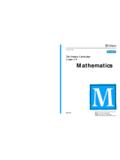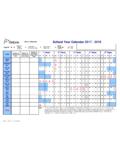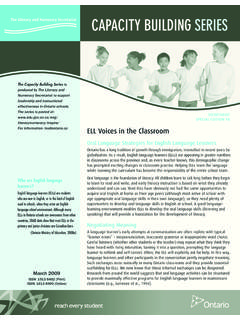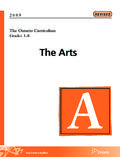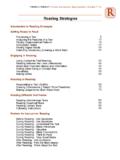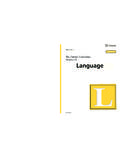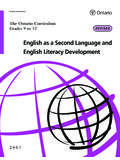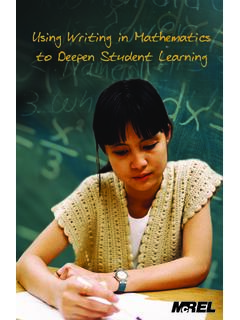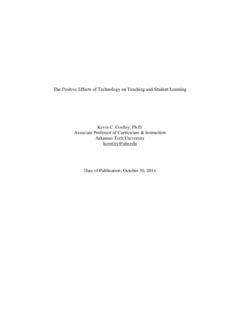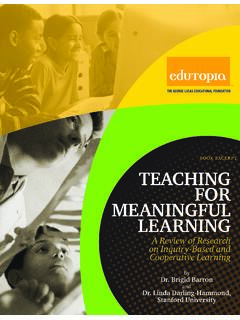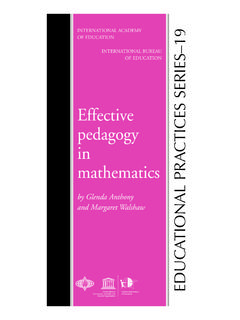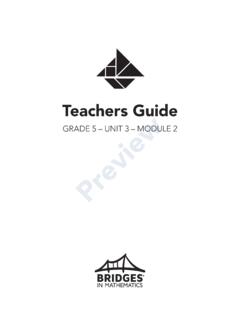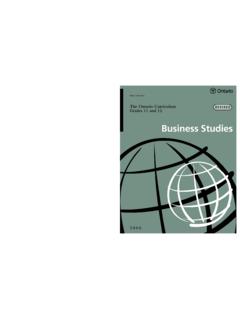Transcription of Capacity Building Series
1 CapacityBuilding SeriesSPECIAL EDITION #27 The Third TeacherDesigning the Learning Environment for mathematics and Literacy, K to 8 Imagine the ideal learning environment for today s learner. What would it look like? Think about how much the world has changed in the last three decades and how rapidly it will continue to change in the years to come. How do we ensure that the instruction we provide is responsive to the shifting demands of the 21st century?Researchers and practitioners in a wide range of disciplines early childhood and developmental education, psychology and cognitive science, school architecture and design maintain that the key to learning in today s world is not just the physical space we provide for students but the social space as well (Fraser, 2012; Helm et al., 2007; OWP/P Architects et al., 2010). The learning environment, they suggest, is the third teacher that can either enhance the kind of learning that optimizes our students potential to respond creatively and meaningfully to future challenges or detract from it.
2 Susan Fraser, for example, writes: A classroom that is functioning successfully as a third teacher will be respon-sive to the children s interests, provide opportunities for children to make their thinking visible and then foster further learning and engagement. (2012, p. 67) Many futurists highlight the importance of innovation, entrepreneurship and creativity in an age of globalization and rapid technological development; others emphasize the importance of communication skills and critical thinking. All concur that developing high levels of literacy and mathematical proficiency will be foundational for success the focus for this monograph. Thinking about the learning environment .. Look at your learning space with 21st century eyes: Does it work for what we know about learning today, or just for what we know about learning in the past? Sir Ken Robinson The Third Teacher (2010)July 2012 ISSN: 1913 8482 (Print)ISSN: 1913 8490 (Online)The Capacity Building Series is produced by the Student Achievement Division to support leadership and instructional effectiveness in Ontario schools.
3 The Series is posted at: For information: Started with the Physical EnvironmentOVERALL ..It is both an art and a science to design (as opposed to decorate) a learning environment that responds to our ultimate goal as educators to develop independent and rigorous thought. Therefore, if we want to foster discovery and reflection, dialogue and the sharing of ideas, the overall physical environment should include: A large gathering space for whole-group work and discussions, located near whiteboards, easels and/or projector screens. A gathering space for small-group and whole-group discussions where students can see clearly the representations of learning that are posted on boards or screens and hear classmates as they share ideas. Flexible and reconfigurable space for small-group collaborative work and inquiry space must allow for groupings of various sizes, such as pairs, triads and groups of four or more. Desks and tables configured to facilitate discussion by allowing eye contact with peers and teacher, the unencumbered flow of traffic and enough space for students to write collaboratively.
4 Active areas for inquiry, investigation and wonder and quiet areas for thinking and exploring technology all areas need to be accessible to students for communicating and documenting their own learning ( , computers, computer software, tablets, digital cameras and video recorders, document cameras, interactive white boards). Instructional materials organized in such a way as to provide easy selection and access for all students materials may include computer software, educational web sites and applications, found materials, graphic organizers, newspapers and other media, resource texts, mathematics ..Mathematically literate students demonstrate the Capacity to formulate, employ and interpret mathematics (OECD, 2012, p. 4); they view themselves as mathematicians, knowing that mathematics can be used to understand important issues and to solve meaningful problems, not just in school but in life. By extension, the physical environment for mathematics learning should include: Spaces where students can use manipulatives to solve problems and record their solutions.
5 Board and/or wall space to display student solutions for Math Congress and Bansho student solutions should be easily visible from the group gathering space. Space to post co-created reference charts such as glossary terms and past and current summaries of learning that specifically support the development of the big ideas currently under study. Instructional materials organized in such a way as to provide easy selection and access for all students ; may include mathematics manipulatives, calculators and other mathematical tools, mathematical texts, hand-held LITERACY .. Today s literate learners experience a constant stream of ideas and information they need strategies for interpretation and making sense and lots of practice in identifying meaning, bias and perspective (Ontario Ministry of Education, 2009, 2006). By extension, the physical environment for literacy learning should include: Spaces where students can talk, listen, read and place for wonder, mystery and discovery.
6 We need to think about creating classroom environments that give children the opportunity for wonder, mystery and discovery; an environment that speaks to young children s inherent curiosity and innate yearning for exploration is a classroom where children are passionate about learning and love school. (Heard & McDonough, 2009)3 Board and/or wall space for co-constructed documentation, anchor charts, shared writing texts, student-generated inquiry questions, etc. A variety of learning materials that are found and often contributed by students and families themselves along with commercial materials that are relevant to the students learning Central writing storage area with a variety of authors writing and publishing supplies along with reference materials like dictionaries, thesauruses, etc. Clipboards and other writing materials located in various areas where students work to allow for writing and recording of thinking A well-stocked, co-constructed classroom library with a variety of text forms, genres and text levels organized and labelled; selections should be changed on a regular basis according to students needs, interests and what they are thinking about at a given the Social EnvironmentKEY COMPONENTS FOR mathematics AND LITERACY LEARNING.
7 Learning is both an internal process of assimilating new information and a social process of discussion and negotiation. Cross suggests that we need to integrate both in the design of learning environments that optimize learning (2009, p. 906). Other education researchers concur, emphasizing that knowledge is constructed through engagement both with ideas and with others. Crick et al. (2007) propose that in order to create a learning environment that builds learning power a teacher must create positive interpersonal relationships, honour student voice and encourage perspective taking. Key components of a rich learning environment are identified below, with some suggestions for classroom practices that support today s EmpowEr studEnt lE arning through collaboration. When students have a sense of belonging and safety within a community of learners, they are empowered to take risks and explore new ideas. This happens best within a collaboratively established structure.
8 students are invited to think about and co-create norms for how they interact with each other. These norms, stated in the students own words, help students take responsibility for their learning and the learning of their classmates. They might include: We will listen carefully to what others are saying with the goal of understanding their thinking and reasoning. We will share our strategies and ideas to contribute to the understanding of others. We will take turns and make sure everyone else has a turn and participates. We will respond to the ideas of others with respect and with interest (for example, by asking a question about a solution or strategy, making a suggestion for a more efficient way to solve a problem or rephrasing to clarify). We will disagree with respect, by giving our reasons for not being in agreement. Our comments and questions will be focused on the mathematics or literacy learning, not the person. Where all learners can make progress.
9 All students and teachers can learn significant mathematics within a nurturing environment, given sufficient time, developmentally appropriate goals, well-considered learning materials, and strategic program, instruction, and assessment. (Literacy and Numeracy Secretariat, 2007) 42. givE wEight to studEnt voicE through dialoguE. When engaging students in dialogue, we give their voice the weight required for them to develop critical thought as they clarify, articulate, justify and synthesize their ideas. Dialogue involves responding to others ideas, sometimes in agreement, sometimes not. It is in this bumping of ideas that students knowledge and understanding will grow. As teachers, we support this process by inviting different students to contribute and to rephrase what others have said. Sometimes the teacher will revoice students contributions to help the progression of the dialogue. Dialogue occurs among all members of the learning community; students talk back and forth with each other, not just in response to teacher prompts.
10 They may question each other s ideas and clarify their own, thus deepening the conceptual understanding of the group. Lucy West, in a recent video, defines five types of math talk that are apt descriptors for language learning as well (Leaders in Educational Thought, 2012). She emphasizes the importance of dialogue in producing robust learning: Rote The teacher drills facts, ideas and routines through constant repetition. Recitation students are asked to recall information provided by the teacher. Instruction The teacher models or explains how to perform a procedure, use a strategy or solve a problem. Discussion students share information, exchange ideas and solve problems together; accountable talk is aimed at leading students toward an acceptable answer or solution. Dialogue students work toward a common understanding by listening to and reflecting upon each other s ideas. 3. Focus on studEnt solutions and intErprEtations.
